-
Key Takeaways
- Agentic AI provides benefits of 20 to 30% efficiency gains and 50% less downtime in manufacturing operations.
- Manufacturers typically get a positive ROI in 18 to 24 months, as a result of multiple improvements in costs and quality.
- AI agents are able to optimize for maintenance, quality, inventory, production, supply chain and sustainability, all at the same time.
- Successful adoption requires goals that are clear, sharing relevant data, securing the right partners, and a pilot-to-scale approach.
- Manufacturers who step up to implement pilot projects using agentic AI will likely benefit from operational efficiencies, customer satisfaction, labor retention, and responsiveness in the market.
Agentic AI in Manufacturing: Use Cases, Applications, and Benefits
Numerous statistics regarding the benefits of AI paint a compelling picture. Manufacturing companies utilizing AI solutions are automatically seeing 20-30% operating efficiencies. With regards to production, downtime is being reduced through AI by almost 50%. Underlying quality defects have been reduced by 35%. It is clear that these are the reasons agentic AI is so important today!
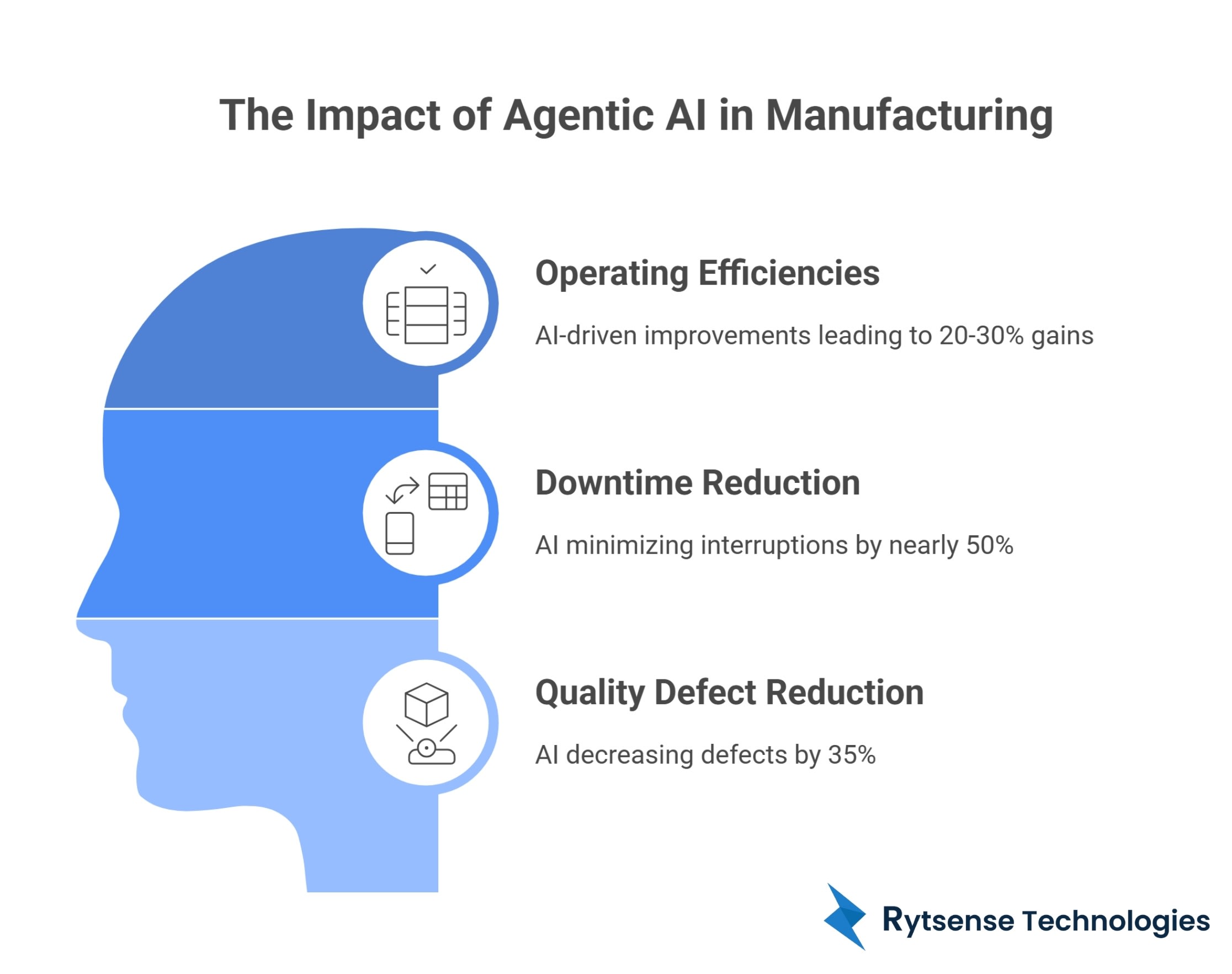
What is Agentic AI in Manufacturing?
In manufacturing, agentic AI is distinct from common automation. Regular automation executes a task in accordance with fixed rules. In contrast, agentic AI responds automatically to changing conditions. Use of agentic AI yields systems that learn from experience - thus, to some extent, improve thought modeling.
The Evolution: From Basic Automation to Agentic AI
The development of Agentic AI in manufacturing represents the next major step in the evolution of manufacturing. These systems are aware of their environment, can choose, and act with little human intervention. They appropriately obtain and use information to assess complex situations that traditional automation systems cannot solve.
Why Agentic AI is Essential for Modern Manufacturing
Is Agentic AI a Trend or a Business Essential?
Unfortunately, traditional methods of handling work, production, and worker shortages fall short at keeping up with the corresponding demands. Manual bottleneck checks and data selection are too slow and limited in scale.
Agentic AI in manufacturing will bridge these enormous gaps while processing vast amounts of data in real time. Business operations can quickly be optimized with higher frequencies.
Benefits of Agentic AI in Manufacturing for Companies and Customers
| Stakeholder | Key Benefits | Impact |
|---|---|---|
| Companies | Production cost reduction | 15-25% savings |
| Energy consumption decrease | 20% reduction | |
| Equipment lifespan extension | 30% increase | |
| Waste minimization | Significant decrease | |
| Response time improvement | Dramatic enhancement | |
| Customers | Product quality consistency | Higher satisfaction |
| Delivery time reduction | Faster fulfillment | |
| Customization options | Greater personalization | |
| Competitive pricing | Better value | |
| Sustainability improvement | Eco-friendly products |
Transform your manufacturing with AI autonomy.
Partner with experts who understand your factory’s needs and can build tailored agentic AI systems for real-world impact.
How Agentic AI Works in Manufacturing Workflows
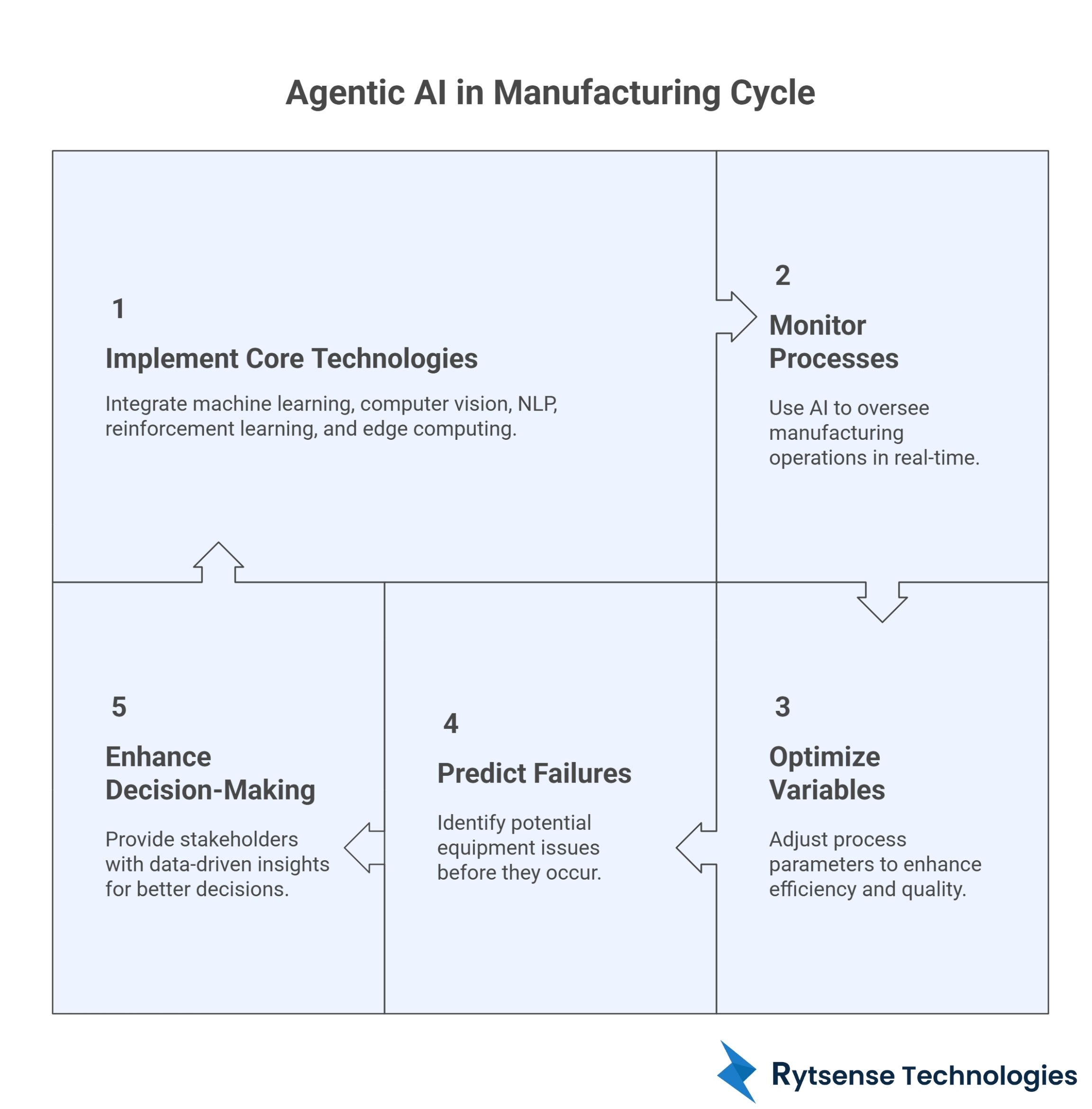
Core Technologies Behind AI Agents in Manufacturing
- Machine Learning: Machine Learning Algorithms can look through previous datasets and learn, finding patterns to the untrained human eye. They can accurately predict future outcomes.
- Computer Vision: Cameras can now be our intelligent eyes. Computer vision can identify problems we can't detect. They can also monitor live process conditions, supporting agentic AI in manufacturing for defect detection and safety compliance.
- Natural Language Processing: Natural language processing now allows machines to understand human language. They can review reports, emails, and many forms of documentation automatically, helping streamline communication workflows in agentic AI in manufacturing systems.
- Reinforcement Learning: Through trial-and-error experience, agents can learn through reinforcement learning. They can adjust their strategies based upon optimizing experiences.
- Edge Computing: Edge computing allows products and processing to happen at the machine.
| Technology | Primary Function | Manufacturing Application | Key Benefit |
|---|---|---|---|
| Machine Learning | Pattern recognition | Demand forecasting, quality prediction | 95%+ accuracy |
| Computer Vision | Visual inspection | Defect detection, safety monitoring | Real-time analysis |
| Natural Language Processing | Communication understanding | Report generation, documentation | Automated workflows |
| Reinforcement Learning | Optimization through experience | Process tuning, scheduling | Continuous improvement |
| Edge Computing | Local processing | Machine-level decisions | Millisecond response |
They provide timely decisions in milliseconds and even in situations of non-connectivity.
How AI Agents Enhance Process Manufacturing
They can predict equipment failures before they occur faster than the owner realizes something is wrong. Simultaneously, they can also balance multiple variables to deliver more consistent product from batch to batch. Then, they can add human supervision into critical processes to reduce human error.
Key Agentic AI Applications in Manufacturing
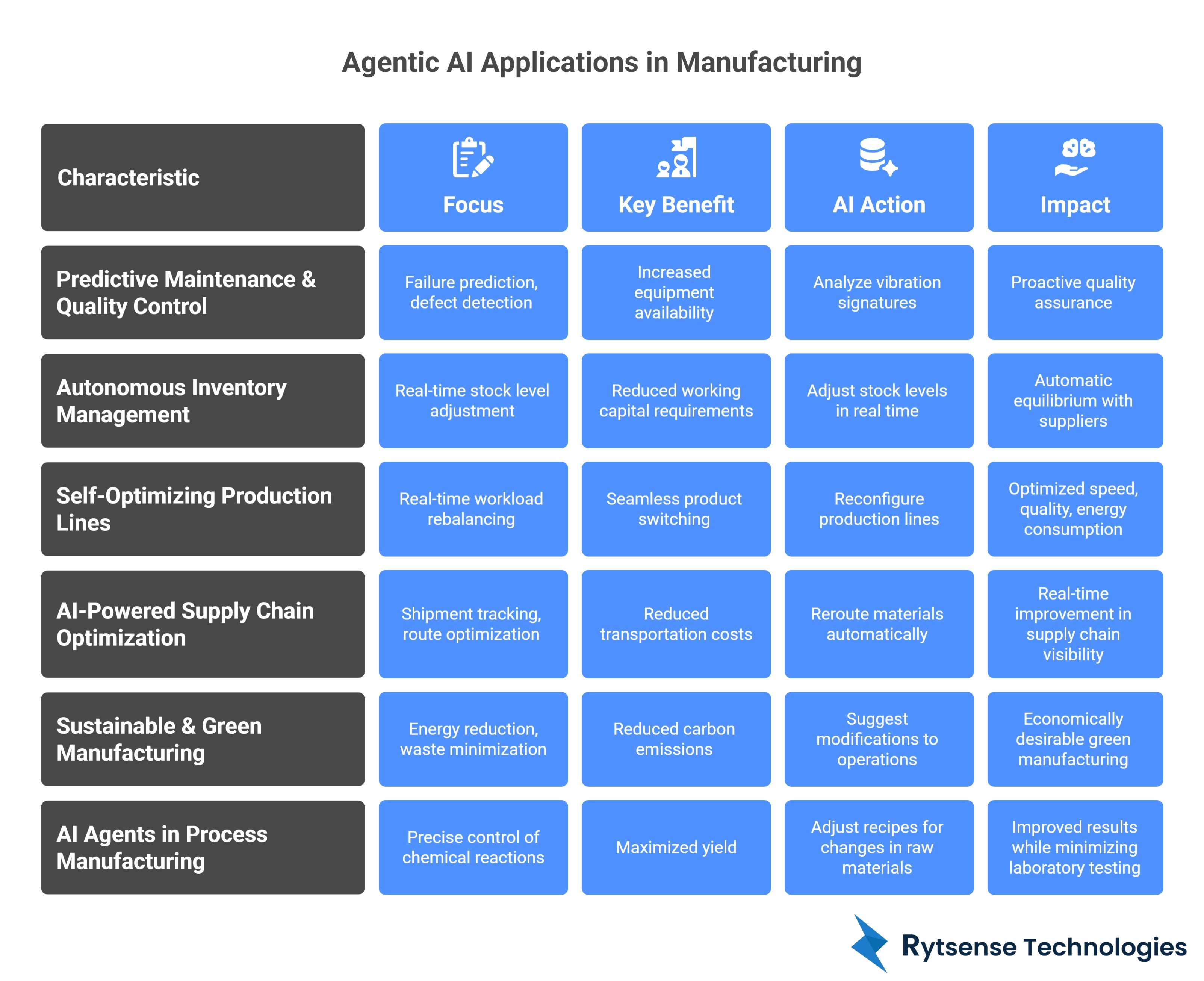
Predictive Maintenance & Quality Control
| Maintenance Approach | Failure Prediction | Downtime | Cost Efficiency |
|---|---|---|---|
| Reactive | None | High (unplanned) | Expensive |
| Preventive | Time-based estimates | Medium (planned) | Moderate |
| Predictive | Weeks in advance | Low (optimized) | High savings |
They offer predictive failure warnings weeks in advance. Maintenance intervention occurs solely during planned downtime. Emergency fixes become exceptionally rare. Equipment availability increases by 20–30%.
Quality assurance shifts from reactive to proactive. Vision systems inspect every product. They detect defects at the microscopic level. They also provide problem root-cause identification automatically. Quality improves and inspection costs drop significantly — a major advantage of implementing agentic AI in manufacturing for end-to-end quality control.
Also Read:
Top AI development companiesAutonomous Inventory Management
- Demand forecast
- Supplier lead-times
- Production schedules
- Storage costs
Autonomous inventory applications adjust stock levels in real time to conserve space and inventory levels to balance stock outs while avoiding excess inventory, establishing an automatic and real-time equilibrium with suppliers, dropping working capital requirements significantly.
Self-Optimizing Production Lines
When demand signals change, production lines can also reconfigure without human intervention switching seamlessly between different products while optimizing speed, quality, and energy consumption at the same time.
AI-Powered Supply Chain Optimization
AI agents can optimize transportation routes on a daily basis, consolidate shipments of multiple suppliers reducing costs, and coordinate with third-party logistics partners automatically in real-time. The visibility in supply chains is generally a real-time improvement as well.
Sustainable & Green Manufacturing
They identify and create opportunities for recycling and reuse. They automatically gather carbon emissions data. They suggest modifications to operations that promote sustainability. Green manufacturing is becoming economically desirable thanks to agentic AI in manufacturing technologies.
| Sustainability Metric | Traditional Manufacturing | AI-Optimized Manufacturing | Improvement |
|---|---|---|---|
| Energy Consumption | Baseline | Optimized usage patterns | 20% reduction |
| Material Waste | 8–12% average | Precision optimization | 35–40% reduction |
| Carbon Emissions | Standard output | Tracked and minimized | 25% decrease |
| Water Usage | Fixed consumption | Dynamic adjustment | 30% savings |
| Recycling Rate | 40–50% | Maximized recovery | 70–80% |
AI Agents in Process Manufacturing
The process industries, such as chemicals, pharmaceuticals, and food processing, have significant potential for AI agent application. AI agents in process manufacturing, with their ability to precisely control complex chemical reactions, can help in consistent batch production. They help to maximize yield and maintain a high safety process.
They can adjust recipes for changes in raw materials. They are able to predict quality outcomes prior to completing production runs. They improve results while minimizing laboratory testing.
“Why Agentic AI is Essential for Modern Manufacturing”
Strategic Agentic AI Use Cases in Manufacturing
Agentic AI will also drive a transformational shift into the manufacturing operation beyond specific applications. This section reviews some of the implications of AI agents such as factory automation, intelligent decision-making, intelligent mass customization, and improvements in machine downtime. Practical examples and actionable insights are delivered for organizational implementation across a diverse manufacturing environment.
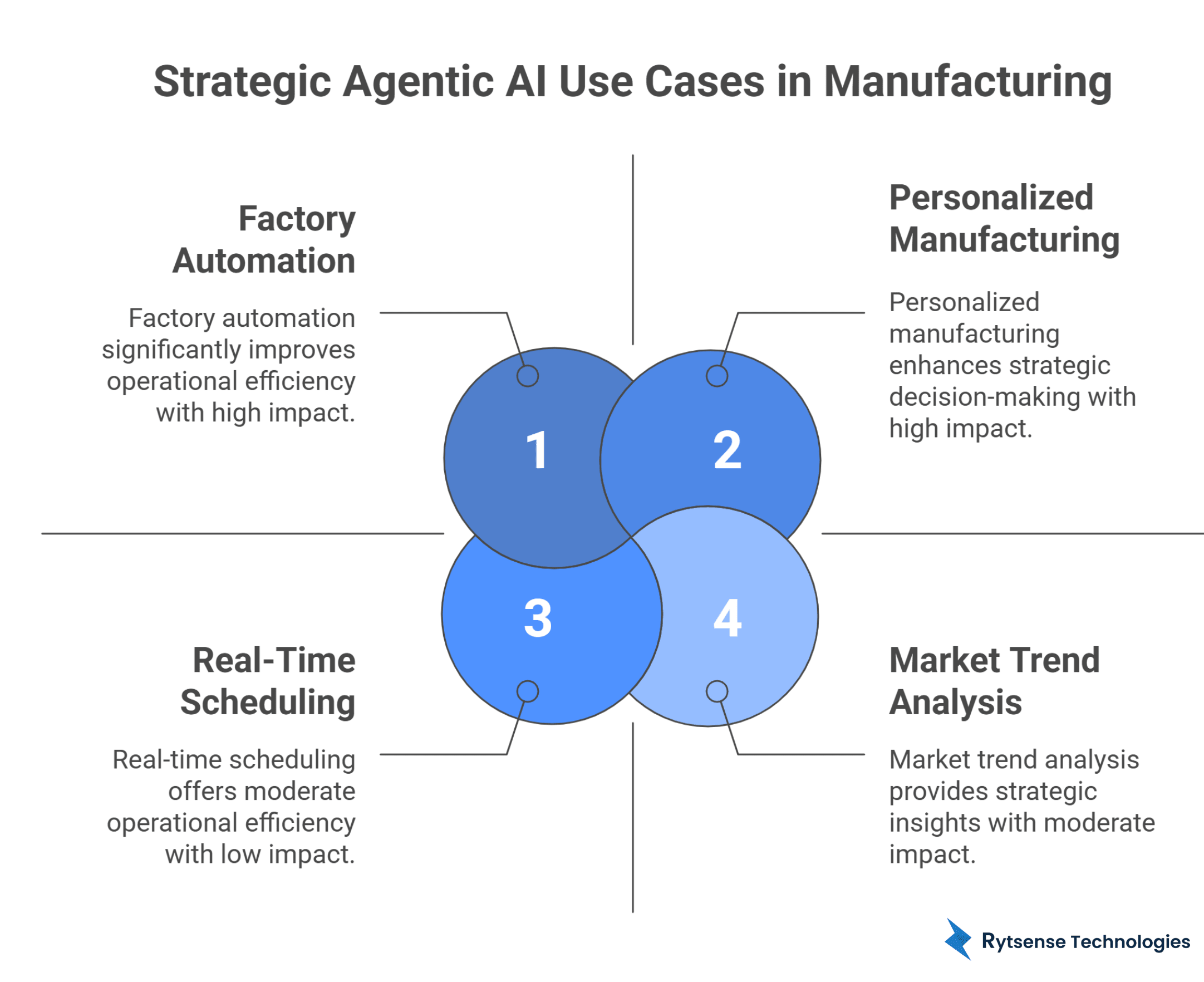
Agentic AI for Factory Automation and Robotics
Robots employ agentic AI to gain autonomy in the manufacturing site. They are able to navigate a factory floor independently. They are capable of adapting to obstacles and changes. They are able to operate side by side with human workers in a safe manner.
These robots can learn tasks based on human demonstration. Every motion of these robots is continuously optimized. All robots engage with one another for coordinated communication and behaviors automatically. Their construction, and the factory environment, is more easily and quickly adjustable, a clear outcome of adopting agentic AI in manufacturing systems.
Ready to overcome workforce shortages, optimize efficiency, and reduce operational costs?
Rytsense Technologies helps manufacturers deploy scalable, secure agentic AI solutions that deliver measurable ROI.
Smart Decision-Making Across Manufacturing Operations
Agentic AI use cases in manufacturing can encompass strategic decision-making. AI agents can assess market trends, the moves of competitors, and the capabilities of the enterprise. They make recommendations for altering production plans. They propose potential new products. They improve pricing plans dynamically. They accurately forecast demand. They aid in scenario plans for high impact decisions.
Personalized Manufacturing for Customers
Mass customization is feasible at an economic cost. AI agents make production proposals for orders at an individual level. They optimize the sequence of the orders for production. They coordinate so that personalization does not hamper production.
Consumers will receive personalized products for almost the same cost as mass-produced items. Lead times will remain the same. There will be little compromise on quality.
Also Read:
AI Development CostReducing Downtime with Agentic AI: A Practical List of Ways
A practical list ways agentic AI can reduce downtime in manufacturing is as follows:
- Predict failures that will warn before a breakdown occurs
- Automatically adjust parameters to avoid quality problems
- Schedule in real time to eliminate idle time
- Manage spare parts intelligently so parts are available when needed
- Help troubleshoot problems quickly
- Rebalance production lines to circumvent process problems
- Monitor suppliers to minimize stockouts on materials
- Monitor energy consumption and reduce downtime due to power fluctuations
- Monitor worker safety to minimize downgrades due to accidents
- Monitor compliance accurately to minimize losses due to compliance issues
The Business Value of Agentic AI in Manufacturing
Decisions about the adoption of technologies are ultimately driven by financial justification. In this section, we will define and quantify the business value related to agentic AI investments, including rapid payback periods, customer retention benefits, improved responsiveness to the market, regulatory savings and compliance benefits, and the ability to attract top talent away from competitors. Actual figures provided in this chapter will reinforce the point that manufacturers cannot delay the implementation of agentic AI in manufacturing.
18–24 Month ROI on AI Implementations
Financial returns occur quickly. Most manufacturing businesses can identify a positive return on investment within two years of implementation. Some businesses will see returns within a 12- to 18-month time frame. The total investment generally falls within the range of $500,000 to $5 million or more, based on the scale and complexity of implementation.
Cost savings will come from a variety of areas: reduced downtime, energy reduction, reduced waste, higher labor productivity, etc. Revenue will increase due to higher throughput and better product quality.
| Phase | Duration | Investment Range | Expected Returns | Key Milestones |
|---|---|---|---|---|
| Pilot Project | 3–6 months | $100K–$500K | Learning & validation, Proof of concept | Initial learning phase |
| Initial Deployment | 6–12 months | $500K–$2M | 15–20% efficiency gain | Single facility success |
| Full Scale Rollout | 12–24 months | $2M–$5M | 25–35% total improvement | Multi-site deployment |
| Maturity & Optimization | 24+ months | Ongoing investment | Sustained competitive edge | Continuous innovation |
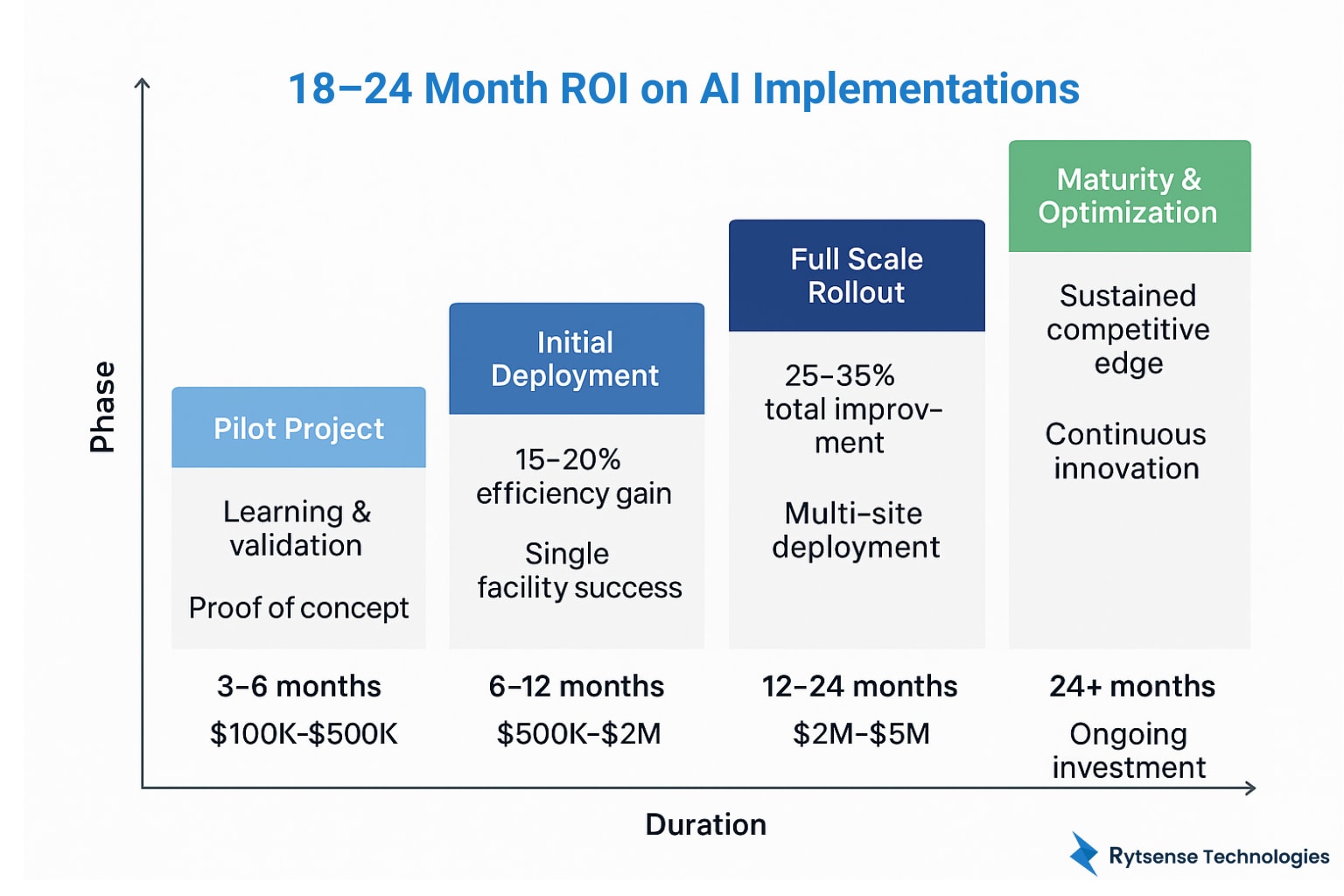
Higher Customer Retention Through Personalization
Agentic AI enables a manufacturing organization to provide customer-specific solutions. Products are manufactured to meet the exact specification needed by the customer. Delivery assurances can be counted on as product manufacturing times are more consistent. Quality of product will always be consistent.
In addition, customer satisfaction will increase, as well as customer retention rates, which can increase 15–25 percent. Lifetime customer value will be greatly increased. Referrals will go up.
Faster Response to Market Changes
Markets are constantly changing. A "traditional" manufacturing organization will spend exponentially longer time successfully adapting (often weeks or longer). An AI-powered manufacturing facility can respond accordingly within days or, more likely, hours.
AI-powered factories and manufacturing facilities can automatically change production schedules. AI can easily and quickly source different options for necessary materials. And AI can adjust capacity across product lines. This will increase competitive advantage.
Meeting Sustainability Regulations
With each passing day it becomes easier to stay compliant with stricter environmental regulations in the manufacturing industry. AI agents can automatically track metrics associated with these requirements, produce required reports, and suggest areas of improvement.
Fines and penalties will be reduced. Corporate reputation will improve. And customer access to those who care about doing business with environmentally-green corporations will increase.
Preventing Talent Drain to Tech-Forward Rivals
Being in a more modern workplace is appealing for younger professionals and manufacturing organizations with AI-powered facilities may have access to better skilled talent. Work has become more interesting and less repetitive.
Companies retain skilled workers longer. Training effectiveness improves. Knowledge transfer is more systematic.
Overcoming Challenges in Adopting Agentic AI
No transformation is without obstacles. This chapter discusses the top three obstacles manufacturers will face with agentic AI adoption: adopting agentic AI technology, interoperating with legacy systems and silo data, providing workforce reskilling and development opportunities, and only embracing agentic AI if it is secure, meets regulatory compliance, and has a scalable implementation plan. Practical strategies are suggested to support manufacturers in working through these obstacles.
Data Integration & Legacy Systems
Legacy equipment is prevalent in many factories. These older systems weren't created to be part of an AI ecosystem. There is a high likelihood the data is siloed and cannot communicate with other systems.
Solutions do exist. In most scenarios a modern middleware solution is capable of connecting older systems to new systems. IoT is ready to offer a way to introduce a level of intelligence into existing equipment.
Cloud-based platforms bring together data sources. In scenarios with existing environments, you can introduce agents without having to migrate data sources. Usually, you will benefit from incremental steps that have been through proper development in a natural way that permits ethical and fair behavior without disrupting the entire business.
Workforce Adaptation & Skill Gaps
There are conditions where workers may believe they may lose their role due to automation. Current skills need to be updated to permit automation in the factory. Change management becomes essential.
Train the workforce on the value of augmented intelligence versus loss of job security. Ensure everyone can develop key skills over time. Factory roles will evolve rather than disappear. Communication needs to remain transparent.
Security, Compliance & Scalability
Connected systems will produce security vulnerabilities. Security regulations apply to many industries and states. Initial tests and deployments must allow for eventual scalability.
Security requires layers at basic levels, which include network, data protection, and access levels. Compliance must allow for a documentation and audit trail based. If there is a contention around compliance, then architecture must assist in scalability through pilot success.
Steps to Get Started with Agentic AI in Manufacturing
Being successful in implementing any new technology requires thoughtful planning and preparation. This section provides a six-step journey for manufacturers who are starting their agentic AI journey: defining what you want to achieve, collecting information from stakeholders about your data readiness and what they need to be successful, vetting your technology partner(s), building your internal team to successfully deploy agentic AI, starting with pilot projects, and developing governance for continual development and sustainment.
Identify Business Objectives & Use Cases
Initial engagement should be around a focused problem. Do not purely chase AI for the sake of proceeding. Start by mapping specific pain points related to risk that have some level of measurement or can be measured: more downtime than typical downtime, production errors related to quality, or supply chain or delivery challenges.
Select use cases based on potential ROI and ease of implementation. Quick wins create a base for momentum. More difficult transformations happen later.
Assess Data Readiness
AI needs quality data. Understand what data, if any, is available. Understand data source. Identify data gaps. Identify what data needs to be collected or created.
Clean existing historical data, and understand governance procedures for the data. Ensure that data flows smoothly from all relevant sources.
Choose the Right Tools & AI Agent Development Services Partner
Selections about technology will matter a great deal. Evaluate technology platforms for features appropriate to your manufacturing environment. Consider ease of integration with the environment.
AI Agent Development Services providers will bring valuable expertise. Look for providers with experience in working with the manufacturing community. Check references completely. Ensure that they understand how you do your work.
Build Internal Capabilities & Upskill Teams
External partners will accelerate implementation. Build internal capabilities to ensure long-term success. Invest in training those in IT, engineers, and operators.
Establish cross-functional teams to combine domain expertise with technical skills. Develop capabilities of data science, in stages.
Start Small, Scale Fast
Begin with pilot projects. Cap pilot projects to clearly establish success criteria and contain projects in one part of the environment. Implement learnings from first projects.
Document lessons learned from the implementation of the first project. Normalize and establish protocols for the now standard group. Gradually expand into other parts of the company. Avoid a big bang deployment.
Implement Continuous Learning & Governance
AI is iterative and only improves over time or by observation. Put processes and protocols in place to confirm learnings. Establish processes to update systems.
Establish governance. Assign rights to determine process changes. Establish policy committee. Establish ethical AI ask questions.
Ready to overcome workforce shortages, optimize efficiency, and reduce operational costs?
Rytsense Technologies helps manufacturers deploy scalable, secure agentic AI solutions that deliver measurable ROI.
Real-World Proven Examples of Agentic AI in Manufacturing
A theory gains credibility only when proven through real-world implementation. This chapter also demonstrates how leading manufacturers apply and leverage agentic AI throughout their operations. Case studies will highlight information from Rytsense Technologies' journey in case study format to demonstrate metrics captured, implementation timelines, and lessons learned that other manufacturers can consider in their own agentic AI initiatives.
How Leading Companies Apply Agentic AI Today
Top tier manufacturers can show proven value. Automotive manufacturers employ AI agents for quality inspection within busy assembly lines. Electronics manufacturers use AI for an optimized production scheduling automatically.
Pharmaceutical manufacturers use AI to monitor equipment to maintain regulatory compliance. Food processors monitor batches of product to consistently meet quality standards. Aerospace manufacturers use AI to predict maintenance for critical components.
Also Read:
Case Study: Rytsense Technologies Manufacturing’s Transformation
When Rytsense Technologies adopted agentic AI at multiple manufacturing facilities it began with predictive maintenance on critical manufacturing engines. The company's results were demonstrated within six months. Unplanned downtime for components fell by 40%.
Maintenance costs declined by 25%. After six months they began expanding agentic AI capabilities for quality control, with vision systems successfully identifying defects in product earlier in the production line. Scrap declined 30%, and customer complaints dropped significantly. The third phase was to include production scheduling.
The company utilized agentic AI to optimize five factories, running simultaneously with AI agents. Throughput increased by 20% without any capital investment for new equipment. A reduction in energy costs of 18% created a positive return on investment in a 16 month implementation process.
The Future of Agentic AI in Manufacturing
Manufacturing technology is developing rapidly. This section outlines emerging trends that are likely to shape the next decade: digital twins, autonomous manufacturing systems, mobile robots, 5G connectivity, and self-optimizing factories. It will explore the role of agentic AI in fostering continuous innovation so that manufacturers can compete in the increasingly dynamic global marketplace.
Next-Gen Trends in Smart Factories
Technology continues to change. Digital twins will become the norm. Production lines will have a mirror factory in a digital environment. Agentic AI agents will optimize both lines in the digital twin and the physical counterpart, sending the requests for optimal process changes for the physical factory.
Autonomous mobile robots will conduct most of the movement of materials. Collaborative robots will work seamlessly alongside humans. The factories will automatically reconfigure to the new products.
Real-time coordination is possible thanks to 5G connectivity, along with instant decision-making through Edge AI and cross-facility optimization through cloud platforms.
Autonomous Innovation for the Next Decade
Agentic AI for manufacturing will continuously improve processes and operations. AI agents will make process improvement suggestions for you, along with identifying new product opportunities.
Generative AI will speed up design of products, resulting in self-optimizing manufacturing processes, while human expertise in the manufacturing process is used for strategic and creative functions.
Unlocking the Full Potential of Agentic AI in Manufacturing
Agentic AI in manufacturing transforms operations in a fundamentally new way. It goes beyond basic automation to take intelligent autonomous action. The technology creates measurable outcomes: lower costs, better quality, and faster responses.
Now, the implementation of this technology cannot be made in absence of a plan. You will need a strategy of some kind. Think about what you want to achieve and be clear on your objectives. You must determine the best partners. You will need to build and develop internal capabilities over time, and then use a scale-up strategy in proportion to immediate outcomes.
The competitive landscape is changing. Early adopters often realise an advantage over their competition. They attract better talent, they are better positioned to serve their customers, and they often have the means to operate at a lower cost. The real question is not whether you will adopt agentic AI but rather how quickly you are ready to start.
The new manufacturing future belongs to those companies who embrace intelligent industrial automation. The technology exists today. The business case is increasingly proving itself time and time again. The conversation will shift to making a meaningful investment, making important choices, and ultimately taking action. Now is your time.
The future of manufacturing belongs to those who act now.
Rytsense Technologies can help your business adopt agentic AI solutions that drive innovation, sustainability, and competitive advantage.
Meet the Author

Karthikeyan
Co-Founder, Rytsense Technologies
Karthik is the Co-Founder of Rytsense Technologies, where he leads cutting-edge projects at the intersection of Data Science and Generative AI. With nearly a decade of hands-on experience in data-driven innovation, he has helped businesses unlock value from complex data through advanced analytics, machine learning, and AI-powered solutions. Currently, his focus is on building next-generation Generative AI applications that are reshaping the way enterprises operate and scale. When not architecting AI systems, Karthik explores the evolving future of technology,where creativity meets intelligence.